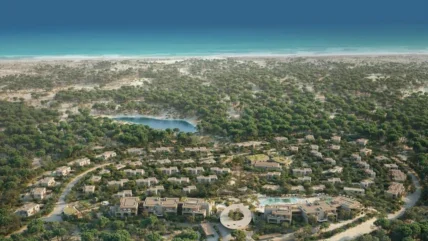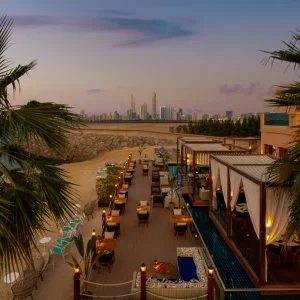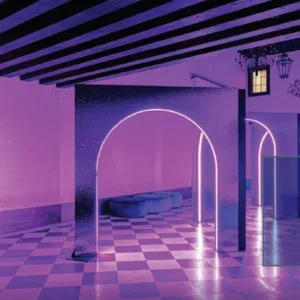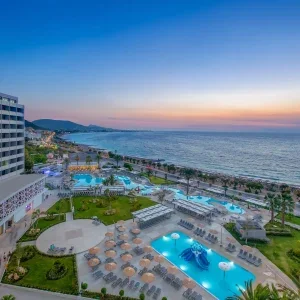
Six Senses Comporta on Portugal’s Alentejo coast and Aman Residences Amangiri in Utah’s Canyon Country may stand continents apart, yet both are rooted in the same ambition: to let nature lead the design narrative.
At Comporta, 400ha of protected pinewoods, dunes and freshwater lakes flow down to 62km of whitesand beach, where a 70-key Six Senses hotel and 58 branded residences will open in 2028. The resort and homes are discreetly sited within a 20ha “build area”, preserving the remaining estate as a nature reserve. In Utah, a dozen Aman Amangiri residences on five to 19 acres each rise amid the ochre-toned mesas of Canyon Point, their poured-concrete walls tinted with recycled fly ash to echo the Grand Staircase cliffs and minimise visual impact. The architectural language at both sites is austere yet tactile: Comporta’s central building fans into wings of guest rooms, with garden and presidential villas punctuating the pine canopy, while three precincts of forest, sand dune and lake residences employ timber, pale limestone and floorto- ceiling glazing to mirror their settings.
At Amangiri, each villa is intentionally positioned “to complement the desert’s spectacular topography”, according to architect Marwan Al-Sayed of MASASTUDIO, ensuring no two homes are identical and that the structures “emerge from the land rather than impose upon it”. These design choices underscore a shared conviction: that luxury is inseparable from sensitivity to place.
Wellness journeys carved by landscape
Beyond their striking forms, both projects embed well-being into their very contours. Six Senses Comporta’s ‘Path of Life’ winds through estate gardens, dunes and wooded glades, a sculptural trail inspired by sacred geometry that guides guests towards communal Earth Lab workshops and Grow With Six Senses children’s programmes.
Spa Comporta, concealed among pine trunks and crowned with living roofs, presents a trio of buildings for movement, treatment and hydrotherapy – each space opening onto natural light, fresh air and the scent of the Mediterranean breeze. Analogously, Aman Amangiri grants residents round-the-clock access to its 25,000ft2 spa, where Navajo healing rituals, steam pavilions overlooking mesas and an Alachen Bar for custom aromatherapy blends extend well-being rituals into desert panoramas. In both cases, treatments become moments of ecological immersion rather than isolated indulgences.
Guided adventures further animate the wellness narrative. Comporta’s beachfront yoga, kitesurfing launches from a private club and equestrian rides through pine groves invite guests to move within nature’s rhythm. At Amangiri, horseback explorations of sandstone valleys, sunrise hot-air balloon flights over the Grand Circle, and guided desert hikes become extensions of spa programming, encouraging mindful engagement with elemental landscapes. In weaving treatment rooms with trails, dunes with dining, both brands dissolve the artificial separation between selfcare and the great outdoors.
Culinary expressions of place
Farm-to-table gastronomy emerges as another dialect of this conversation between architecture and environment. Six Senses Comporta’s main restaurant sources seasonal harvests from on-site vegetable gardens under its Eat With Six Senses ethos, pairing heirloom tomatoes and wild herbs with Alentejo wines for menus that taste of salt-tinged air and sun-baked earth.
Aman Amangiri’s private Chef’s Table events in concealed courtyards showcase south-western flavours accentuated by desert-foraged juniper, sage and cactus fruits, while community-style dinners under starlit canyons foster social bonds in the remote wilderness. Both properties champion minimal-waste kitchens and zero single-use plastics, reinforcing a holistic pledge to sustainability.
In Comporta, the Alchemy Bar invites guests to craft natural spa products from native botanicals – an interactive fusion of mixology and aromatherapy that mirrors the site’s botanical diversity. Amangiri’s Alachen Bar echoes the concept in a desert key, guiding guests through custom essential-oil blends drawn from juniper, cedar and desert blooms. These hands-on rituals elevate food and drink into living expressions of each locale’s flora.
Sustainability as the ultimate luxury
For both developments, environmental stewardship is embedded in every decision. On Portugal’s Blue Coast, pinelands and dunes were mapped by drone to define building footprints that avoid mature trees; solar panels and geo-exchange systems power spa facilities, while wastewater is treated and reused in gardens. In Utah, carbon-neutral construction employs fly-ash concrete, passive climatic design with roof overhangs and ‘slot canyon’ windows for natural ventilation, and low-impact site grading to protect cryptobiotic soil crusts – practices that reduce energy use by up to 40% compared with conventional builds. Both brands view these measures not as add-ons but as prerequisites for authentic luxury.
João Cabaça, co-founder and CEO of VIC Properties, casts Comporta as “the start of a journey rooted in respect, authenticity and connection… a lasting legacy that respects the land and ensures a sustainable future for the estate”. Meanwhile, Robert Hee, CEO of Canyon Equity, notes of Amangiri Residences that “residences have always been part of the vision… evolving the concept to where we are satisfied” – a nod to the project’s decade-long alignment with desert conservation efforts. Their words reflect a paradigm shift: true luxury today is measured by a property’s ecological footprint as much as by its service offerings.
As travellers increasingly seek sanctuaries that feed both body and soul through authentic engagement with place, Six Senses Comporta and Aman Residences Amangiri stand as exemplars of spa-hotel residences reimagined. They teach us that the ultimate amenity is not marble-floored lobbies or gilded trimmings, but the profound sense of belonging that arises when architecture, sustainability and wellness converge in harmony with the natural world.
Core principles of biophilic design
- Natural patterns and forms: Using local stone and wood finishes that mirror surrounding geology and vegetation.
- Indoor-outdoor connectivity: Expansive glazing and open-air pavilions that dissolve boundaries between guest rooms and nature.
- Living systems: Incorporating green walls, vegetable gardens, and green roofs to enhance biodiversity and guest well-being.
- Sensory variation: Designing pathways, textures and water features that create dynamic light and soundscapes, engaging all the senses.
Programming for mind, body and spirit
- Mindfulness trails and canyon meditation circuits encourage mental clarity and stress reduction.
- Farm-to-table dining and culinary workshops leverage local produce, reinforcing the connection between nutrition, environment and well-being.
- Interactive eco-labs teach sustainable practices, aligning guest behaviour with property-wide commitments to zero plastic waste and minimal carbon footprints.
- Guests learn local heritage through guided heritage walks and communityled workshops.






